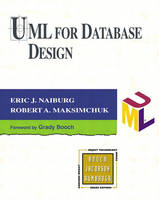
UML for Database Design
Addison Wesley (Verlag)
978-0-201-72163-8 (ISBN)
- Titel ist leider vergriffen;
keine Neuauflage - Artikel merken
Typically, analysis, development, and database teams work for different business units, and use different design notations. With UML and the Rational Unified Process (RUP), however, they can unify their efforts -- eliminating time-consuming, error-prone translations, and accelerating software to market. In this book, two data modeling specialists from Rational Software Corporation show exactly how to model data with UML and RUP, presenting proven processes and start-to-finish case studies. The book utilizes a running case study to bring together the entire process of data modeling with UML. Each chapter dissects a different stage of the data modeling process, from requirements through implementation. For each stage, the authors cover workflow and participants' roles, key concepts, proven approach, practical design techniques, and more. Along the way, the authors demonstrate how integrating data modeling into a unified software design process not only saves time and money, but gives all team members a far clearer understanding of the impact of potential changes. The book includes a detailed glossary, as well as appendices that present essential Use Case Models and descriptions. For all software team members: managers, team leaders, systems and data analysts, architects, developers, database designers, and others involved in building database applications for the enterprise.
Eric J. Naiburg is a product manager for Rational Software Corporation, focusing on the Rational Rose product line. His professional focus is on extending the ability of Rational Rose to support database design and object-relational mapping within the Rose visual modeling tool and the UML. He delivers numerous popular seminars on the topic. Robert A. Maksimchuk is the Data Modeling Evangelist for Rational. He is a frequent speaker at Rational events, various database conferences, and user groups worldwide, and has more than twenty-four years of experience in the software development field. 0201721635AB06272001
Foreword.
Preface.
The Approach.
Chapter Summaries.
Acknowledgments.
1. Introduction.
Why Read This Book?
Who Should Read This Book?
How To Read This Book?
2. Database Design From Requirements to Implementation.
Database Modeling vs. Database Design.
Data Modeling Today.
UML Diagrams for Database Design.
UML Differs From Traditional Database Modeling.
The Case Study.
3. Business Modeling for Database Design.
The Workflow.
The Case Study Status.
The Concepts.
The Approach.
The Design.
4. Requirements Definition.
The Workflow.
The Case Study Status.
The Concepts.
The Approach.
The Design.
5. Analysis and Preliminary Design.
The Workflow.
The Case Study Status.
The Concepts.
The Approach.
The Design.
6. Preparing For Transformation to the Database Design Model.
The Workflow.
The Case Study Status.
The Concepts.
The Approach.
The Design.
7. Database Design Models-UML Profile for Database Design.
The Workflow.
The Case Study Status.
The Concepts.
The Approach.
The Design.
8. Implementing the Physical Aspects of the Database.
The Workflow.
The Case Study Status.
The Concepts.
The Approach.
The Design.
9. Summary of Using the UML for Database Design.
The Workflow.
The Case Study Status.
The Approach.
The Design.
Glossary.
Appendix A: The Models.
Organization.
The Business Use Case Models.
The Business Object Models.
The Traditional Conceptual Data Models.
The System Use Case Models.
The Design Models.
The Database Design Models.
Appendix B: The Use Case Descriptions.
Index.
| Erscheint lt. Verlag | 20.8.2001 |
|---|---|
| Verlagsort | Boston |
| Sprache | englisch |
| Maße | 186 x 234 mm |
| Gewicht | 490 g |
| Themenwelt | Mathematik / Informatik ► Informatik ► Datenbanken |
| Mathematik / Informatik ► Informatik ► Programmiersprachen / -werkzeuge | |
| Informatik ► Software Entwicklung ► Objektorientierung | |
| ISBN-10 | 0-201-72163-5 / 0201721635 |
| ISBN-13 | 978-0-201-72163-8 / 9780201721638 |
| Zustand | Neuware |
| Haben Sie eine Frage zum Produkt? |
aus dem Bereich


